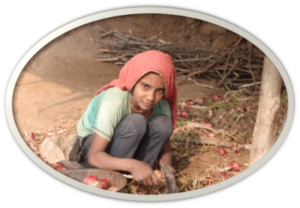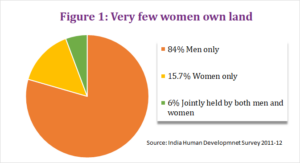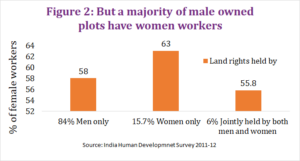
by Dr Pallavi Choudhuri (NCAER)
India is 69 percent rural (2011-12), and agriculture remains the dominant form of employment, playing a pivotal role in the rural economy, although its share has been declining. Land is an important productive resource in agriculture, but what do know about land ownership?
 Official statistics such as the 2015-16 Agricultural Census indicate that women farmers comprise only 13.9 percent of operational holders. However, operational land is used by anyone for agricultural production – with or without land rights, and hence, is not reflective of the ownership pattern of arable land. This makes survey data the only fallback option for examining distributional patterns in land ownership.
Official statistics such as the 2015-16 Agricultural Census indicate that women farmers comprise only 13.9 percent of operational holders. However, operational land is used by anyone for agricultural production – with or without land rights, and hence, is not reflective of the ownership pattern of arable land. This makes survey data the only fallback option for examining distributional patterns in land ownership.
Data from the Indian Human Development Survey (IHDS, 2011-12) show that 60 percent of rural households own agricultural land. But as Figure 1 shows, ownership rights are heavily skewed, with the majority of arable land owned by men only.
With increased non-farm employment for rural men, farm work often falls to women. As of 2011-12, the IHDS data show 45 percent of working-age women working in the agricultural sector – 36.5% in household farms and 16% hired as agricultural labour. Disaggregation by ownership pattern, we find that women work in 58% of households where only men hold land (84% of all land-owning households – see Figure 1). In households where women own land, work participation in family farms is 63% in households where only women hold land ownership and 55.8% in households with joint ownership (see Figure 2).
 Arable land is an important input in the agricultural production process and women’s property rights can ensure their social security by enhancing nutrition and household food security, along with providing access to institutional credit, inputs and productive resources, and enhancing their bargaining power both within and outside the household (Agarwal 1998). Secure land rights for women have been recognized as an important pillar for achieving Sustainable Development Goals in its references to poverty, hunger, and gender equality, and is recognised under two SDG indicators (SDG 1 and SDG 5).
Arable land is an important input in the agricultural production process and women’s property rights can ensure their social security by enhancing nutrition and household food security, along with providing access to institutional credit, inputs and productive resources, and enhancing their bargaining power both within and outside the household (Agarwal 1998). Secure land rights for women have been recognized as an important pillar for achieving Sustainable Development Goals in its references to poverty, hunger, and gender equality, and is recognised under two SDG indicators (SDG 1 and SDG 5).
The National Policy for Farmers (2007) recommended adopting a broader definition of farmers to include agricultural labourers, tenants, etc. However, the government confers the status of a “farmer” based on ownership rights, more specifically on land title records. Lack of land titles, thus, may prevent women from accessing agricultural extension programs such as government offers of subsidized seeds and fertilizers, irrigation facilities, and other services such as crop insurance, when the land they till is not in their name; this may even leave women farmers vulnerable to shocks from a natural disaster or climate change. Further, women’s land rights are not always recognised in village land records, with gender-disaggregated data often unavailable in official records.
Registration of land titles is often a clumsy and onerous process, and women often lack knowledge of inheritance laws. A 2013 study carried out by UN Women and RDI in the states of Andhra Pradesh and Bihar noted that only 60 percent of the plots reported in the survey were formally documented with a title. Around 25 percent of the plots lacked any type of document, while around 7 percent of the plots had only informal documentation. Further, women held titles in less than 10 percent of households with formal documentation. The study also noted that overall, more than 61 percent of women have never visited the local revenue office for land-related paperwork, while another 18 percent visited only with a male relative. Such issues highlight the fact that the challenge of bridging the gender gap in land rights needs a multi-faceted approach. These issues are further highlighted in articles presented in this measurement brief. In particular, this brief discusses the following:
****************************************************
Pallavi Choudhuri is a Senior Fellow at the National Council of Applied Economic Research. Her primary research interests are in the area of poverty, informality, employment, and gender. At NCAER, her recent work has focused on measurement gaps in the income and consumption data and women’s paid and unpaid work. Prior to joining NCAER, Choudhuri taught courses in Economics at the Grand Valley State University as a Visiting Assistant Professor. She has a PhD. in Economics from the University of Wyoming.